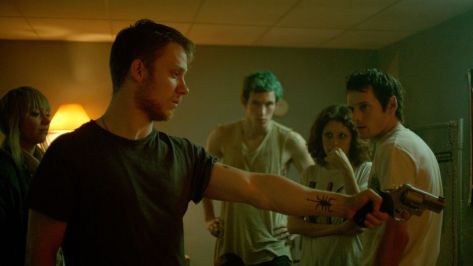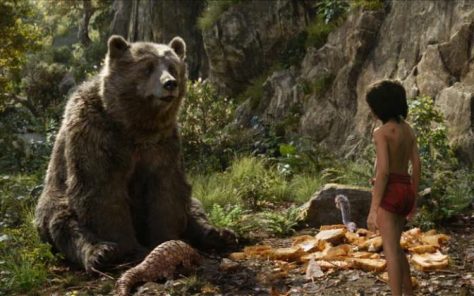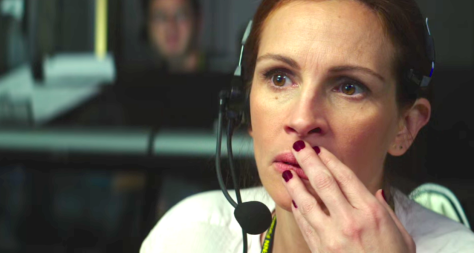by Danny Stout
“Slasher” films are dubious at best in LDS circles, and outright rejected at worst. Opponents struggle to find redeeming value in violence-as-entertainment, while fans talk of high-tension thrills and chills, or the fun of “freaking out.” Three new movies, Hush, The Green Room, and the TV dramatic series, Slasher, are challenging the kitch-based ultra violent genre that’s kept us screaming, and, in some cases laughing, for decades. The brand-new works retain spurious elements of past slashers (e.g., story begins with youth trauma, followed by revenge, typically with metal weapons by the wounded protagonist that usually wears a hockey mask or other creepy costume), yet the recent works have depth, finer craftsmanship, and moral commentary. Filmmakers increasingly discard the pejorative “slasher” in favor of the euphemistic “psychological thriller” or “psychological horror film.”
Something like the slasher has been around for centuries. Peasants attending London’s Elizabethan Theater demanded murder  from Shakespeare who delivered it in high doses, Hamlet being an example. Actors in a play bereft of death scenes were bombarded by rotten vegetables by a deliriously discontented audience. Today, “scary” movies function similarly to their fifteenth century progenitors of the stage. Religionists struggle to sort out the moral questions. That is, not all violence is as easily denounced as that in the brutal The Texas Chain Saw Massacre (1974). War movie Saving Private Ryan has a 30-minute scene of non-stop death, but is praised as a moral work. The Passion of Christ while lauded as a religious film, had bloodshed throughout as Mel Gibson strove for historical accuracy. Nevertheless, the “Slasher” pushes the limits of taste and morality.
from Shakespeare who delivered it in high doses, Hamlet being an example. Actors in a play bereft of death scenes were bombarded by rotten vegetables by a deliriously discontented audience. Today, “scary” movies function similarly to their fifteenth century progenitors of the stage. Religionists struggle to sort out the moral questions. That is, not all violence is as easily denounced as that in the brutal The Texas Chain Saw Massacre (1974). War movie Saving Private Ryan has a 30-minute scene of non-stop death, but is praised as a moral work. The Passion of Christ while lauded as a religious film, had bloodshed throughout as Mel Gibson strove for historical accuracy. Nevertheless, the “Slasher” pushes the limits of taste and morality.
The new films are more like Alfred Hitchcock‘s Psycho; they’re more morality tales than traditional slashers designed merely to exploit audience catharsis and adrenaline rushes. The shower scene murder was unprecedented, but the overall allegory is about conscience, repentance, and circumstances beyond one’s control. The Green Room, Hush, and Slasher while violent, have redeeming value beyond the traditional gore fests such as Halloween (1978), and Friday the 13th (1980). The three recent films are gory, but thoughtful; there’s fewer graphic scenes, emphasizing other dramatic elements, particularly character development and substantive plots, elevating moral themes.
In Hush, Maddie, a deaf writer played by Kate Siegel has an intruder hovering outside her remote cabin. His weapons include a machete and crossbow. Reading his lips, she decodes his message: “I’m not coming in until you want to die.” Murder is kept to a minimum because, thematically, the wonder of mind and spirit in outfoxing an overpowering foe is the gestalt. Conceding my reductionist take, the film deals with problem-solving in the wake of intense fear. While few of us will receive a visit from a deranged killer with a crossbow tonight, all have anxieties at various levels. In an impossible situation, Maddie finds a way to pause, think, and perhaps engage a higher power in discovering that fear, not the intruder, is the real threat.
The Green Room (i.e., chamber for performers before and after their acts) takes us into the punk rock culture, as the band, “The Ain’t Rights” reluctantly agree to play for neo-Nazi skinheads in a club outside Portland, Oregon. Opening their set with a song mocking Skinheads is the first mistake. Second, they witness a murder, and are locked in the Green Room; a roller coaster of rabid realism takes off. Like Hush, the violence is graphic, but not like Wes Craven‘s A Nightmare on Elm Street (1984) or Clive Barker‘s Hellraiser (1987).
Band members Sam, Pat, Tiger, and Reece give us a tour of punk life; the film takes on an ethnographic feel. Viewing it through an anthropological lens, the viewer is enlightened about the utility of punk community and its often misunderstood youth culture. Rituals such as “gobbing” (i.e., spitting at the band in appreciation) will intrigue uninformed audience members. How a functional subculture blends with a dysfunctional one such as the Skinheads is equally informative. Again, the violence, although salient, takes a backseat to the film’s engrossing setting.
Of the three, Slasher is truest to the genre in terms of frequency of meat cleaver deaths. Such is partly attributed to it being a dramatic series, and thus a longer story line. It also exceeds the sexuality quotient for LDS tastes. Nevertheless, Slasher is a whodunit focusing on who is killing as much as how. It works as mystery suspense in a traditional sense. Produced by the Canadian network Super Channel, Katie McGrath plays a newly wed returning to Waturbury, Ontario to uncover the story of her parents’ murder. It was the “Executioner,” following the List of The Seven Deadly Sins much like the movie, Seven. The tension builds gradually through the eight episodes with believable twists and surprises. It is a slasher – mystery hybrid.
Vacillating scenes from close-ups to distant shots of the town evoke the Hitchcock technique of giving the viewer time to ponder. Campy elements reminiscent of older slashers add humor with lines like: “I’m beginning to think that moving back to Waterbury was a bad idea.” And “The hard work is going to be the death of you.” Slasher ostensibly is a commendable old fashioned mystery main course with a side order of gore.
technique of giving the viewer time to ponder. Campy elements reminiscent of older slashers add humor with lines like: “I’m beginning to think that moving back to Waterbury was a bad idea.” And “The hard work is going to be the death of you.” Slasher ostensibly is a commendable old fashioned mystery main course with a side order of gore.
Popularity of these films among LDS moviegoers is difficult to predict, but one thing is clear: The slasher genre is changing, and it will be increasingly difficult to assess as demonstrated by the films discussed. Moral values and assumptions of these works are not easily assessed. Whether one is better or worse having seen them cannot ne answered here, but all three have provoked mostly substantive discussion it seems.



 fly on a private jet for the same price as an economy seat? Brian Brushwood reveals these and many other secrets and shortcuts to save time and make life better in an HBO series called, “Hacking The System”. Brushwood, a former student at the
fly on a private jet for the same price as an economy seat? Brian Brushwood reveals these and many other secrets and shortcuts to save time and make life better in an HBO series called, “Hacking The System”. Brushwood, a former student at the  we can be at times. That is where these “hacks” truly serve. Maybe we are not pushy enough to try and “work the system” into free airline upgrades, but being informed on how to best protect yourself can serve all. Not everyone is out to get you, but just as inspired men have counseled, we need to be prepared.
we can be at times. That is where these “hacks” truly serve. Maybe we are not pushy enough to try and “work the system” into free airline upgrades, but being informed on how to best protect yourself can serve all. Not everyone is out to get you, but just as inspired men have counseled, we need to be prepared.
 Do you want what’s best for your children, or do you just want them to be the best? That is the fundamental question behind the HBO documentary, Trophy Kids. In 90+ minutes, we see the daily routines and struggles of six individuals across four different sports. All are talented and have developed amazing skills, but behind every athlete, there is a parent who will do anything to “help” their child become the best. Each parent goes about coaching and training their son or daughter in their own way. There is no doubt that they are passionate about what they do, but does their overwhelming passion actually help their children in the long run?
Do you want what’s best for your children, or do you just want them to be the best? That is the fundamental question behind the HBO documentary, Trophy Kids. In 90+ minutes, we see the daily routines and struggles of six individuals across four different sports. All are talented and have developed amazing skills, but behind every athlete, there is a parent who will do anything to “help” their child become the best. Each parent goes about coaching and training their son or daughter in their own way. There is no doubt that they are passionate about what they do, but does their overwhelming passion actually help their children in the long run? of her.” Sadly, that is a light example of the verbal abuse that these children receive. All reflect the attitudes that their parents have towards officials, competitors, and even their own abilities. On the one hand, a father claims he sits in the back enjoying the game, but soon he joins other rabid parents, complaining about the coach and referees; his arrogance reaches a climax when he screams how bad his son’s teammates are with their parents sitting next to him.
of her.” Sadly, that is a light example of the verbal abuse that these children receive. All reflect the attitudes that their parents have towards officials, competitors, and even their own abilities. On the one hand, a father claims he sits in the back enjoying the game, but soon he joins other rabid parents, complaining about the coach and referees; his arrogance reaches a climax when he screams how bad his son’s teammates are with their parents sitting next to him.
 Marvel’s Captain America: Civil War is taking the country by storm. Although technically a Captain America movie featuring Marvel characters, fans of Thor or Hulk might be disappointed they don’t make an appearance. On the other hand, interesting new characters make their debut.
Marvel’s Captain America: Civil War is taking the country by storm. Although technically a Captain America movie featuring Marvel characters, fans of Thor or Hulk might be disappointed they don’t make an appearance. On the other hand, interesting new characters make their debut. grasp the characters in the way that screenplay writers
grasp the characters in the way that screenplay writers 

 On the other hand, as per usual with Greenaway, it’s all kind of unpleasant. Make that very unpleasant. Some of that unpleasantness is earned; the film intelligently and perceptively considers power and its abuses, and abusive power behaves badly. In this the film goes beyond the level of platitude and self-serving—the specificity, of the thing, both historically and methodologically, is positively Brechtian. And the picture, this detailing of the ways of political oppression, isn’t likely to be very pretty.
On the other hand, as per usual with Greenaway, it’s all kind of unpleasant. Make that very unpleasant. Some of that unpleasantness is earned; the film intelligently and perceptively considers power and its abuses, and abusive power behaves badly. In this the film goes beyond the level of platitude and self-serving—the specificity, of the thing, both historically and methodologically, is positively Brechtian. And the picture, this detailing of the ways of political oppression, isn’t likely to be very pretty. that seems at once really well-researched/historically plausible, and really humanly accurate. After all, the muck of medieval subsistence is still not so terribly far in the past. Unfortunately, this is also, on the side of the apparent good guy, the source of most of the aforementioned unpleasantness. Rembrandt’s efforts come more or less to naught, the which conclusion—remember, the writer/director is telling this particular story for a reason—contains the message of the movie. It’s a practically Buñuelian vision of human perfidy. Is Buñuel so set on the futility of it all? It’s more than that, really. Misanthropy is one thing. Vicious misanthropy might go a bit too far.
that seems at once really well-researched/historically plausible, and really humanly accurate. After all, the muck of medieval subsistence is still not so terribly far in the past. Unfortunately, this is also, on the side of the apparent good guy, the source of most of the aforementioned unpleasantness. Rembrandt’s efforts come more or less to naught, the which conclusion—remember, the writer/director is telling this particular story for a reason—contains the message of the movie. It’s a practically Buñuelian vision of human perfidy. Is Buñuel so set on the futility of it all? It’s more than that, really. Misanthropy is one thing. Vicious misanthropy might go a bit too far.

 Favreau struggles to do the writer
Favreau struggles to do the writer 

